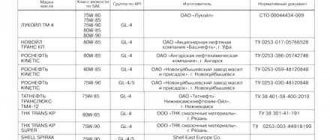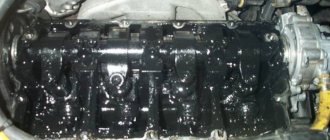Checking the condition of the transmission of a Chevrolet Lacetti is carried out after 15 thousand kilometers or once a year. If necessary, the inspection is accompanied by cleaning, repair and topping up of technical fluids. In a Chevrolet Lacetti, changing the gearbox oil is not provided by the manufacturer. However, the need for maintenance arises when switching to another viscosity class, major repairs, or long-term operation. If you have the necessary tools and minimal experience, changing the oil in a Lacetti manual transmission can be done at home.
Procedure for changing transmission oil
Changing the oil in a Chevrolet Lacetti gearbox is not a complicated procedure, but it requires strict implementation of the algorithm of actions.
- We warm up the transmission fluid of the gearbox to standard operating temperature - about 70 - 80 ° C. To do this, just drive a few kilometers or let the engine idle for 10 - 15 minutes.
- We install the car on a flat horizontal platform, it is best to use an inspection hole, overpass or lift. We brake the car with the parking brake and place chocks under the wheels.
- We unscrew the filler and control hole plug for better atmospheric pressure. This will help the waste fluid flow out of the gearbox more easily. The filler plug functions as a breather. Therefore, when reassembling, you need to clean its channels.
Note. The control plug is sealed with a rubber gasket. We replace the pressed, hardened and torn gasket with a new one.
- At the bottom, if there is protection, it can be removed to provide access to the pallet. Use the “13” socket to loosen the mounting bolts of the pallet. We place an empty container under it to collect waste liquid. Use a screwdriver to pry up the pan, the oil will begin to drain.
- After the main volume of oil has drained, you can completely unscrew and remove the pan to clean the old gasket and sealant.
Note. The pan gasket must be replaced each time the bottom cover is removed. When buying a new gasket, you need to take into account the number of crankcase cover mounting bolts. There are pallets with 10 and 11 bolts, depending on the year of manufacture of the car.
- Reinstall the bottom cover and fill in new oil. On a Lacetti, manual transmission oil can be filled in two ways: through the control hole using an oil pump or through the filler plug using a watering can with a long funnel. When the oil begins to flow out of the control hole, tighten the control and filler plugs.
After successfully completing the required operations, you need to start the engine and inspect the pan for leaks. At this point, the oil change for the Lacetti manual transmission is completed; all that remains is to periodically check its level in accordance with the vehicle service regulations.
Stages of replacing fluid in an automatic transmission of a Lacetti car
An oil change can be complete or partial. For an incomplete replacement, one person will be enough - the car owner himself. And to completely replace the lubricant in a Lacetti machine, you will need an assistant.
Partial replacement of ATF Mobil in Lacetti
An incomplete oil change in Lacetti automatic transmissions is carried out as follows:
- Place the car on the pit. Place the selector lever in the “Parking” position.
- Warm up the gearbox to 80 degrees Celsius.
- Turn off the engine.
- Unscrew the drain plug and drain the liquid into a measuring container placed just under the pan.
- Wait until it completely flows into the container.
- Then see how much was drained. The amount of liquid in the container usually does not exceed 4 liters.
- Screw in the drain plug.
- Insert a funnel into the hole for filling oil in the automatic transmission and fill in the same amount of fresh fluid as was poured out.
- Get behind the wheel and start the engine.
- Move the speed selector through all gears as follows: “Parking” - “Move forward”, again “Parking” - “Move backward”. And do this with all selector positions.
- Turn off the engine.
- Check oil level.
- If everything is normal, then you can start the car and drive out of the pit. If it’s not enough, then you should add a little more and repeat step number 10 again.
Read
Do-it-yourself complete and partial oil change in the Renault Megane II automatic transmission
A partial oil change can only be carried out if the quality of the Lacetti automatic transmission fluid meets the standard: light and viscous. But it happens that wear products rise and pass into the filter, clogging it and changing the quality of the liquid. In this case, it is recommended to carry out a complete replacement.
Completely drain and fill with new oil
A complete gearbox oil change involves removing the pan, cleaning the elements and replacing the Lacetti automatic transmission gaskets. An assistant should be nearby.
- Start the engine and drive the car into the pit.
- Place the box slide in the “P” position.
- Turn off the engine.
- Remove the drain plug.
- Place the container for drainage and wait until the liquid has completely drained from the pan.
- Then, using wrenches, remove the bolts holding the pan cover.
- Clean the pan from burning and black deposits. Remove any shavings from the magnets.
- Replace the rubber gasket.
- If necessary, you will also need to replace the oil filter.
- Put the cleaned pan with a new gasket back.
- Tighten it with bolts and tighten the drain plug.
- Measure how much has drained. Fill in only three liters from the drained ones.
- After this, the car owner needs to take the return hose from the radiator.
- Place it on the tube and insert the end into a two-liter plastic bottle.
- Now you need action from an assistant. He must get behind the wheel and start the engine.
- The Lacetti machine will start working and the liquid will flow into the bottle. Wait until the latter is filled and stop the motor.
- Add the same amount of new oil to the Lacetti automatic transmission. The amount of liquid poured will be 9 liters.
- After this, install the tube in place and put on the clamp.
- Start the engine again and warm it up.
- Check the transmission fluid level.
- If there is a slight overflow, then drain this amount.
Read
Do-it-yourself complete and partial oil change in automatic transmission AL4
Thus, the car owner can make a replacement in the Lacetti gearbox with his own hands.
Checking the oil level
While the machine is operating, periodically (every 15,000 km) you need to check the condition of the transmission fluid. Since the design of the unit does not include a dipstick, the lubricant level in the Lacetti gearbox is monitored using a control hole.
To complete the work, a certain algorithm of actions is required.
- Place the vehicle on a flat horizontal surface.
- Using a socket “13”, unscrew the hole bolt for checking the lubricant level. This bolt is located on the right side of the crankcase along the direction of the car in the area of the CV joints.
- At a normal level, the lubricant will be at the edge of the hole or at its lower edge.
If the lubricant level cannot be monitored, topping up is necessary. You need to pour oil into the Lacetti gearbox the same way you did when replacing it.
Important. You need to add oil that has the same technical characteristics as the oil in the gearbox.
Reviews
Valentina, Tver region. I have a basic Lacetti with a 1.4-liter engine and a five-speed manual transmission. The car was purchased second hand, the 2011 model has been in use for about a year. With a mileage of 110 thousand km, a lot of things fell off and were replaced by the previous owners, but thank God I still have to fill the oil. After all, in a year the car never broke down. It’s clear that many people overtake me, honk, etc. The modest 1.4 engine is saved only by the mechanics, which squeeze all the juice out of the engine. In the city you can keep within 10 liters/100 km.
Recommended volumes and principle of lubricant selection
Chevrolet Lacetti cars are equipped with a 4-speed automatic transmission or 5-speed manual transmission. For each type of transmission, the manufacturer provides a specific brand and volume of oil to be filled.
| Element | Let's talk | Application | |
| Automatic transmission | 1.6D | 5.77±0.3 l | It is recommended to use fluids that meet the quality standards of JWS 3309, Esso ATF LT 71141 (yellow) or Total ATF H50235. |
| 1.8D | 6.9±0.3 l | ||
| Manual Transmission | 1.8±0.3 l | Semi-synthetic oils that meet the SAE 80W specification, for vehicles operating in extremely low temperatures - SAE 75W - 90. | |
The recommended oils shown in the table are typical of currently manufactured products. In the future, they may change in accordance with the requirements of the automaker.
Selecting transmission oil
When choosing transmission fluid, you must consider the following basic principles:
- SAE specification - determines the thermal stability of the oil. The temperature-viscosity qualities of the oil depend on the ambient temperature. The SAE indicator determines in what temperature range the composition can be used for efficient operation of the unit.
- ·API tolerances – detailed recommendations on the applicability of products to a transmission of a certain type and transmission mechanism.
- Type of lubricant – mineral water, semi-synthetic, synthetic.
The following brands of oils are suitable for changing the oil in a Chevrolet Lacetti manual transmission:
- Mobil ATF 3309. Used in automatic transmissions with controlled slip lock. Maintains manual transmission cleanliness at factory condition.
- ISU DEXRON III. Suitable for most Chevrolet Lacetti automatic transmissions with servo drive and anti-slip lock. Meets and exceeds the latest requirements of the world's leading DEXRON manufacturers from GM.
- Castrol Manual EP SAE 80W-90. Transmission oils based on mineral oils purified by catalytic hydrocracking.
- Mobil ATF LT 71141. Semi-synthetic ATF product for robotic, automatic transmissions. Optimal frictional properties of the fluid ensure smooth gear shifting.
Oil filter
- 1 Oil filter
- 2 Checking the level and filling the oil in the automatic transmission on a Chevrolet Lacetti
- 3 Choosing oil for manual transmission on a Chevrolet Lacetti
- 4 Checking the oil level and filling the manual transmission on a Chevrolet Lacetti
Along with replacing the hydraulics, you need to change the oil filter. Its service life coincides with the fluid change interval. Disposable product. External metal case, paper filling inside. Passing through the paper, the liquid is cleaned, metal shavings and impurities settle, clean oil circulates inside the system.
Note to the driver. There are three types of cleaning elements that are installed on a Chevrolet Lacetti: full-flow, partial-flow, combined. The main difference between each is the filtration mechanism.
- SCT: the products of the German manufacturer have proven themselves well in the domestic market. The product is resistant to mechanical damage, with a good filter element inside;
- Union: Japanese manufacturer famous for introducing modern technologies. Cleaning filters are certified according to the requirements of the international standard ISO 9002;
- Mann: a German manufacturer that produces high quality filters at an affordable price for the Chevrolet Lacetti.
Oil change intervals
Changing the oil in the Lacetti box is not provided by the manufacturer. This means that the transmission fluid is filled for the entire period of operation of the car. But the manufacturers do not specify that the service life of the car is a relative value and amounts to 150 thousand km or 5 years of operation (the period before major repairs). Therefore, of course, it is necessary to change the oil in a Chevrolet Lacetti manual transmission, preferably without waiting for repairs.
The frequency of changing the transmission depends on the following factors:
- Lubricant quality. For original products, the established service life is within 100 - 150 thousand km. When using cheaper analogues, replacement must be carried out every 75 thousand kilometers.
- Operating mode. An aggressive driving style, increased load, and driving in “start-stop” mode leads to premature oxidation and thickening of the transmission oil.
- Climatic features of the region. Sudden temperature changes, harsh climatic conditions, and high humidity significantly reduce the service life of the oil.
Properly selected transmission fluid increases the efficiency of the gearbox, reduces fuel consumption, and ensures smooth gear shifting.
General Motors says practically nothing about the need to change the oil in the Chevrolet Lacetti gearbox. There is not even a drain hole in the gearbox pan, which means changing the oil only when absolutely necessary after repairing the gearbox. Nevertheless, transmission oil, like motor oil, loses its properties over time - viscosity, detergent properties, lubricating properties. It turns out that an oil change in the Lacetti gearbox is still necessary. Which oil to choose, how to check the level, when to change, let’s figure it out together.
Algorithm for changing the oil in a manual transmission on a Chevrolet Lacetti
In the process of changing the oil in the manual transmission.
In addition to the standard set of tools and a container for draining the oil, you will need to use either a filling syringe or a special funnel with a long hose for filling.
First you need to warm up the engine!
Before draining the old oil, the engine must be warmed up to operating temperature and the vehicle must be placed on an overpass or inspection hole. The process of changing the oil in a Lacetti manual transmission is no different from replacing the transmission on other cars, the only difference is that there is no drain hole, so to drain it you will have to unscrew the transmission pan.
Replacement is performed in the following sequence:
- We install the warmed-up car on an inspection hole or on an overpass (lift).
- Open the hood, find the breather and unscrew it. This is necessary to ensure that the oil drains as much as possible.
Oil leaked from the manual transmission.
The pallet has been removed. You can inspect the inside of the box.
We apply sealant. You don't need much.
Pour oil into the filler hole.
Over time, after a short mileage, you need to make sure that the pan gasket does not allow new oil to pass through. The oil change is complete, all that remains is to check its level every 15 thousand km and rest assured about the gearbox for 80–90 thousand. Good luck with the replacement and smooth gear shifts!
Oil change and control standards
Almost every package of gear oil indicates its expiration date; on average, it is 5–6 years.
Appearance of old dirty manual transmission oil.
General Motors, for its part, says that the oil is poured into the box for the entire life of the car and must be replaced only if the gearbox is repaired.
Capacity and volumes
The Lacetti gearbox holds about 1.8 liters of oil, but the factory recommends filling no more than 1.6 liters , explaining that the load on the seals will be too high, and this can lead to their leakage and failure.
Checking the oil level
In this case, it is necessary to check the transmission level at least once every 15 thousand km.
Most Lacetti owners still prefer to change the oil in the box with a period of 80–90 thousand km. On average, once every two years.
Now all that remains is to check the oil level. This can only be done on a lift or on a viewing hole.
- The inspection hole is located on the side of the crankcase in the area of the constant velocity joint on the right side.
- The plug is unscrewed, after which oil should appear or begin to flow out of the hole. In this case, the level is considered normal.
Chevrolet Lacetti manual
Chevrolet Lacetti Checking the fluid level in the automatic transmission
It is advisable to check the fluid level in the automatic transmission every 15 thousand kilometers or when malfunctions are detected in the operation of the box and fluid leaks on its crankcase.
We show checking the fluid level in the automatic transmission of a car with a 1.6 engine. Automatic transmission fluid level indicator
We carry out the check immediately after the trip (so that the fluid in the gearbox is warmed up to operating temperature - 70–80°) - on a horizontal platform, with the engine idling and the selector (gear selection lever) in position “P”. Before removing the liquid level indicator, carefully remove dirt from the surface of the parts in the immediate vicinity of it. It is unacceptable for even a small amount of foreign particles to enter the internal cavity of the gearbox, as this can disrupt its normal operation and cause increased wear of the mechanism parts. We remove the fluid level indicator from the transmission guide tube. To check the condition of the liquid, blot the indicator with a white sheet of paper. The liquid should be clear. A fine suspension, brown or black in color, clearly visible on white paper, indicates severe wear of the clutches. In this case, you should contact a service station to diagnose the gearbox. Using a clean, lint-free rag, remove any remaining liquid from the indicator and insert it into the guide tube until it stops. We take out the pointer again and determine the location of the liquid film on the pointer.
Location of control marks on the liquid level indicator
The fluid volume in the transmission is normal if the edge of the fluid film is located between the two HOT (“hot” zone) marks on the indicator. If the edge of the film is below the “hot” zone marks, you need to add liquid. If necessary, add fluid recommended by the manufacturer to the gearbox. Pour the liquid into the indicator guide tube using a funnel in small portions, controlling the level. The automatic transmission on a car with a 1.8 engine does not have a fluid level indicator. The fluid level in the gearbox is determined through the control hole (closed with a plug) located in the gearbox housing under the housing of the outer joint of the right wheel drive. We check the level under the same conditions (see above) by unscrewing the plug. The fluid level in the gearbox should reach the lower edge of the inspection hole. If the level is low, add the fluid recommended by the manufacturer to the gearbox using a transmission oil syringe. The maximum permissible fluid level must not be exceeded, as this may lead to gearbox failure.
Source
Which oil to choose for a manual transmission on a Lacetti?
Liqui Moly is very popular among Chevrolet Lacetti owners.
Any transmission oils can be classified according to two standards - SAE and API . According to the first classification, the transmission is designated by two numbers: the first shows the minimum temperature index at which the box is lubricated, the second is the maximum temperature index at which the oil does not lose viscosity.
For example, 75W-80 oil can operate normally in the temperature range from -40 to +35 degrees, and the operating range of 85W-90 oil is from -12 to +45 degrees.
Transmission synthetics should be chosen from the point of view of climatic conditions . In addition, it must be taken into account that it is undesirable to use a more fluid oil after a more viscous one, since this can cause leaks of oil seals and gearbox gaskets.
You will also need a pan gasket.
According to the API standard, transmission oils for manual transmissions are indexed with the letters GL and one number from 1 to 5. Each oil has different extreme pressure and anti-wear additives.
Factory recommendations
For the Chevrolet Lacetti, General Motors recommends using oils that meet GL4 quality standards.
Castrol oil has proven itself to be excellent.
of SAE 75W-90, API GL4 standards is quite suitable for the Lacetti manual transmission . The oil manufacturer does not play a special role; here you can choose at your own discretion.
For example, they speak well of oils:
- Castrol TAF-X, Ravenol 75W90 GL4,
- branded factory GM 75W-90
- Castrol Syntrans 75W90.
In addition to changing the oil, you will need to buy a new gearbox pan gasket (depending on the year of manufacture, the gasket may have either 10 or 11 holes), as well as sealant and find a container where the oil will be drained.
Mechanical Features
When changing the oil in a Chevrolet Lacetti manual transmission, you need to take into account the characteristics of the selected lubricant. Each fluid has its own characteristics in anti-wear and extreme pressure additives. According to API standards, transmission oils used in cars with a manual transmission are indexed with numbers from 1 to 5 and the letters GL, as we wrote above. For a longer period of operation, we pour only synthetic fluid into the mechanics, which will ensure good, uninterrupted operation of the transmission.
What kind of oil to pour into a manual transmission of a Chevrolet Lacetti
Changing the oil in the gearbox of the popular Chevrolet Lacetti is not a difficult task. This procedure is available to everyone, even inexperienced car enthusiasts. It’s quite another thing to choose the right lubricant so that it provides maximum service life. This article provides recommendations on this issue using the example of a Chevrolet Lacetti with a manual transmission.
Is it worth changing the oil?
Before you buy oil, you need to decide whether it is worth replacing at all. So, first of all, let’s pay attention to the replacement regulations specified in the user manual for the Chevrolet Lacetti. Usually the manufacturer indicates a fairly large interval, which is only relevant for European countries with favorable climatic and road factors. For Russia, with its harsh climate, it is necessary to change the oil every 15-20 thousand kilometers. This is an unofficial recommendation, which is quite successfully followed by experienced owners of Chevrolet Lacetti with manual transmission.
Selection of oil by parameters
We will not delve too deeply into the topic of oil parameters, and will consider only the most optimal options. Especially for the Chevrolet Lacetti manual transmission, we can recommend Ravenol 75W90 Getriebeoel TSG GL-4 oil. This is a semi-synthetic product, which will be the best option in terms of price-quality ratio. Of course, this lubricant is much more expensive than pure mineral oil, but it has more stable beneficial properties - both at low and high temperatures. Let us highlight the following advantages of the product from Ravenol:
- Protection of manual transmission components from premature wear
- Effective cooling of all transmission parts
- Stable operation of the box under increased load
- Optimal viscosity level, adapted even to temperatures above 40 degrees
- High thermal stability
- Adaptability to extremely low temperatures
- Good compatibility with elastomers, namely resistance to the spread of corrosion
- Reducing the effect of “dry friction” of parts
- Affordable price
Other brands
The owner of a Chevrolet Cruze always has the right to choose - purchase an expensive original product, or buy something cheaper, but no worse than the original. There are many analogues on the market, the quality of which cannot be doubted. For example, among them it is worth highlighting such as Shell, Mobile, Castrol, Total, ZIK and Motul. The most important thing is to pay attention to viscosity parameters, tolerances and quality standards. The optimal parameters are indicated as API GL-4, SAE 75W-90/80W-90.
In first place in terms of wear resistance is Motul Gear 300 75W-90. Second place goes to Castrol Syntrans Transaxle 75W90, and third place to Mobil Mobilube 75W90.
All three oils work ideally in temperature ranges from – (minus) 35 to +35 degrees.
An alternative option is Lukoil TM-4 75W-90. This is a good semi-synthetic oil, inferior in parameters to most imported lubricants. And yet, this product is well adapted to low temperatures. This model has the lowest cost among foreign oils for Chevrolet Lacetti manual transmission.









